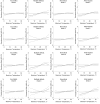Risk of Congenital Heart Defects after Ambient Heat Exposure Early in Pregnancy
- PMID: 27494594
- PMCID: PMC5226695
- DOI: 10.1289/EHP171
Risk of Congenital Heart Defects after Ambient Heat Exposure Early in Pregnancy
Abstract
Background: Congenital heart defects may be environmentally related, but the association with elevated ambient temperature has received little attention.
Objectives: We studied the relationship between outdoor heat during the first trimester of pregnancy and risk of congenital heart defects.
Methods: We carried out a retrospective cohort study of 704,209 fetuses between 2 and 8 weeks postconception from April to September in Quebec, Canada, 1988-2012. We calculated the prevalence of congenital heart defects at birth according to the number of days women were exposed to maximum temperature ≥ 30°C. In log-binomial regression models, we estimated prevalence ratios (PR) and 95% confidence intervals (CI) for the relationship of temperature with seven critical and eight noncritical heart defects, adjusted for pregnancy characteristics.
Results: Prevalence of congenital heart defects was 979.5 per 100,000 for 10 days or more of temperature ≥ 30°C compared with 878.9 per 100,000 for 0 days of exposure. Temperature was more precisely associated with noncritical than critical defects, which had lower prevalence. Fetuses exposed to 15 days of temperature ≥ 30°C between 2 and 8 weeks postconception had 1.06 times the risk of critical defects (95% CI: 0.67, 1.67) and 1.12 times the risk of noncritical defects (95% CI: 0.98, 1.29) relative to 0 days. Associations were higher for atrial septal defects (PR 1.37, 95% CI: 1.10, 1.70) than for other noncritical defects. For atrial septal defects, associations with elevated temperatures began the 3rd week postconception.
Conclusions: Extreme heat exposure during the first trimester may be associated with noncritical heart defects, especially of the atrial septum. Citation: Auger N, Fraser WD, Sauve R, Bilodeau-Bertrand M, Kosatsky T. 2017. Risk of congenital heart defects after ambient heat exposure early in pregnancy. Environ Health Perspect 125:8-14; http://dx.doi.org/10.1289/EHP171.
Conflict of interest statement
The authors declare they have no actual or potential competing financial interests.
Figures




Comment in
-
Hot Days in Early Pregnancy: A Potential Risk Factor for Congenital Heart Defects.Environ Health Perspect. 2017 Jan 1;125(1):A25. doi: 10.1289/ehp.125-A25. Environ Health Perspect. 2017. PMID: 28055942 Free PMC article. No abstract available.
References
-
- Agay-Shay K, Friger M, Linn S, Peled A, Amitai Y, Peretz C. Ambient temperature and congenital heart defects. Hum Reprod. 2013;28:2289–2297. - PubMed
-
- Auger N, Fraser WD, Healy-Profitós J, Arbour L. Association between preeclampsia and congenital heart defects. JAMA. 2015;314:1588–1598. - PubMed
-
- Auger N, Naimi AI, Smargiassi A, Lo E, Kosatsky T. Extreme heat and risk of early delivery among preterm and term pregnancies. Epidemiology. 2014;25:344–350. - PubMed
-
- Ávila P, Mercier LA, Dore A, Marcotte F, Mongeon FP, Ibrahim R, et al. Adult congenital heart disease: a growing epidemic. Can J Cardiol. 2014;30(12) suppl:S410–S419. - PubMed
Publication types
MeSH terms
Grants and funding
LinkOut - more resources
Full Text Sources
Other Literature Sources
Medical
Research Materials
Miscellaneous

